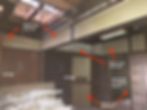Machiya Renovation Tip (1)
- Shinya Yamada
- Apr 5, 2023
- 3 min read
Updated: Aug 14, 2023
Renovating Machiya often involves removal of the existing walls & posts. But what about the seismic safety? It can be addressed by integrating structural retrofit and seismic diagnosis in the renovation design.

Common Removal of Structural Components
The wall between the existing old kitchen and the adjoining tatami rooms is commonly removed. Other walls are often removed as well in order to create an airy open floor plan.
All those items to be removed are earthquake-resisting components. For seismic safety, their loss should be addressed by properly designed structural retrofit. Depending on whether your Machiya is a row house or not, different approaches can be taken.

Row House Type Structural Retrofit
In the case of a row house type Machiya, here are a couple of things to be considered.
Cannot Be Too Strong
This might be counterintuitive, but increasing your row house's seismic resistance (i.e. making your house structurally stiffer) alone significantly more than that of adjoining row houses would cause detrimental effect, since all the row houses' structures are laterally continuous, any stiffer portion - in this scenario your house- would end up receiving all the other houses' seismic loads. It would also create imbalanced rigidity in the whole joined structure of all the row houses, which in turn could cause destructive twisting movement during a severe earthquake.
Preventing a Total Collapse
Safety is not just about seismic resistance. When seismic resistance increase is limited, preventing a total collapse becomes even more relevant for occupants' life safety and evacuation. Various metal straps / connectors can be installed at the timber joinery connections to keep them from falling apart. It is important those retrofit items permit the joinery connections' inherent deformation through which seismic forces are absorbed.
In addition, the structure should be kept unanchored to the foundation as per the original structure. Traditional timber structures are simply erected on foundation stones which provides a condition somewhat akin to seismic base isolation. Also, the bases of posts should be also linked together by new lowered horizontal tie members or sole plates. This row house type structural retrofit was implemented for YA's 3R House project.

Detached House Type Structural Retrofit
For a detached single house Machiya, two approaches would be possible.
One simpler, perhaps less expensive approach would be the same as the row house type outlined above. This approach would suit a partial or limited renovation scope project.
Similar to a modern timber framing house construction, the other approach would make the structure significantly stiffer and rigidly anchored to new concrete foundation. This would mean installing components such as high-strength plywood shear walls, stronger plywood floor diaphragms, corner metal bracings, diagonal seismic lumber braces, seismic dampers, etc. in conjunction with various metal connectors. This approach generally suits full renovation projects. YA's Cathedral Hallway House project is an example of this type of structural retrofit approach.


Balance is Crucial in Structural Retrofit
In all cases, structural retrofit should be designed to create a balanced seismic resistance distribution within the whole structure to avoid destructive building movements in the event of severe earthquakes. It also should be integrated in the overall renovation design to balance with the budget, aesthetics, and other spatial requirements. Structural retrofit design process involves computer-aided seismic diagnosis and simulation which enable numerous design adjustments in sync with the overall architectural design.
Summary
Machiya's traditional structure can be modified to create airy open floor plan spaces, however, not without properly designed structural retrofit that addresses the removal of earthquake-resisting walls, etc.
Integrating structural retrofit design and seismic diagnosis into the design process is crucial to a successful renovation in balance with aesthetics, cost-effectiveness, and safety.
References
日本構造技術者協会 関西支部 Japan Structural Consultants Association Kansai Chapter. 2014. 京町家の限界耐力計算による耐震設計及び耐震診断・耐震改修指針(増補版)[Seismic Resistance Design, Diagnosis, and Retrofit Principles Based on Limit Strength Calculation Method (Revised Edition)]. Kyoto: Kyoto City Planning Department





























